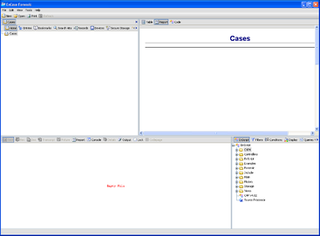This article needs additional citations for verification .(June 2017) (Learn how and when to remove this template message) |
The topic of this article may not meet Wikipedia's general notability guideline .(June 2017) (Learn how and when to remove this template message) |
| Original author(s) | DFLabs Inc |
|---|---|
| Developer(s) | DFLabs Inc |
| Last release | version 2.0 (Jan 2009) |
| Platform | LAMP |
| Available in | JavaScript, PHP, Perl |
| Type | Digital forensics |
| License | shareware/commercial |
| Website | http://ptk.dflabs.com/ |
PTK Forensics (PTK) was a non-free, commercial GUI for old versions of the digital forensics tool The Sleuth Kit (TSK). It also includes a number of other software modules for investigating digital media. The software is not developed anymore.

The graphical user interface is a form of user interface that allows users to interact with electronic devices through graphical icons and visual indicators such as secondary notation, instead of text-based user interfaces, typed command labels or text navigation. GUIs were introduced in reaction to the perceived steep learning curve of command-line interfaces (CLIs), which require commands to be typed on a computer keyboard.

Digital forensics is a branch of forensic science encompassing the recovery and investigation of material found in digital devices, often in relation to computer crime. The term digital forensics was originally used as a synonym for computer forensics but has expanded to cover investigation of all devices capable of storing digital data. With roots in the personal computing revolution of the late 1970s and early 1980s, the discipline evolved in a haphazard manner during the 1990s, and it was not until the early 21st century that national policies emerged.

The Sleuth Kit (TSK) is a library and collection of Unix- and Windows-based utilities to facilitate the forensic analysis of computer systems. It was written and is maintained primarily by digital investigator Brian Carrier.
PTK runs as a GUI interface for The Sleuth Kit, acquiring and indexing digital media for investigation. Indexes are stored in an SQL database for searching as part of a digital investigation. PTK calculates a hash signature (using SHA-1 and MD5) for acquired media for verification and consistency purposes. [1]

The digital forensic process is a recognized scientific and forensic process used in digital forensics investigations. Forensics researcher Eoghan Casey defines it as a number of steps from the original incident alert through to reporting of findings. The process is predominantly used in computer and mobile forensic investigations and consists of three steps: acquisition, analysis and reporting.

A cryptographic hash function is a special class of hash function that has certain properties which make it suitable for use in cryptography. It is a mathematical algorithm that maps data of arbitrary size to a bit string of a fixed size and is designed to be a one-way function, that is, a function which is infeasible to invert. The only way to recreate the input data from an ideal cryptographic hash function's output is to attempt a brute-force search of possible inputs to see if they produce a match, or use a rainbow table of matched hashes. Bruce Schneier has called one-way hash functions "the workhorses of modern cryptography". The input data is often called the message, and the output is often called the message digest or simply the digest.
In cryptography, SHA-1 is a cryptographic hash function which takes an input and produces a 160-bit (20-byte) hash value known as a message digest – typically rendered as a hexadecimal number, 40 digits long. It was designed by the United States National Security Agency, and is a U.S. Federal Information Processing Standard.



